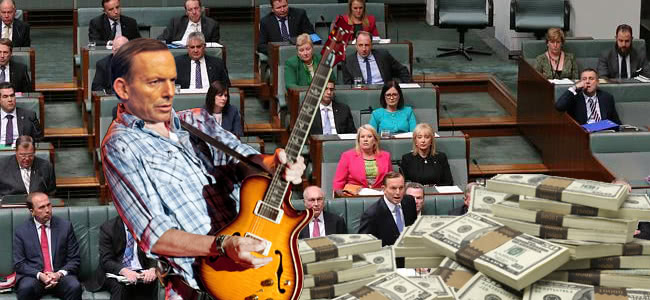Those who’ve been keeping an eye on Tone Deaf over the last couple of days will have seen the sea of eyebrows raised over the government’s handling of what we’ll for all intents and purposes refer to as Stephanie-gate.
For those who aren’t caught up on the situation, the federal government recently launched a website to help explain the 2015 Budget to small business owners. One of the examples used was an independent musician named Stephanie.
According to the site, Stephanie “performs in a band that she runs as a small sole trader” and her “taxable income in 2015-16 is $300,065”, which entitles her to a tax cut of $1,000. It didn’t take long before Stephanie became a national headline.
As Tone Deaf noted, if Stephanie does indeed rake in $300,065 as a musician, it would mean she is not only earning more than your average AFL player, who pull in about $251,559, but more than a federal backbencher, who take home $195,130.
Meanwhile, independent label Valve Records broke down the $300,065 figure on their Facebook page. According to the label, for a three-piece to generate such an income per member would require an overall income of $1.2-1.4 million.
We decided to dig a little deeper and looked at a survey of Australian musicians conducted by the Australian Music Industry Network (AMIN), which acts as a representative body for musicians in Australia, and a 2011 report by Ernst & Young.
According to both of these studies, not only are most independent musicians in no position to be listing ‘Music Professional’ as their primary source of income on their tax returns, but of those that do, most earn somewhere between $7,000 and $12,000 per year.
After we shared the studies with you, our readers, we received a few comments suggesting we get off the government’s back. After all, the $300,065 was likely just a typo and this whole thing is just making a mountain out of a molehill.
Well, according to the government, they don’t think that six-figure sum is as farfetched as everyone’s saying it is. Speaking to Fairfax, a spokeswoman for the Treasurer’s office confirmed that the Stephanie case study was fictional.
The spokeswoman said the case studies used on the budget website “are cameos, so there is no ity Stephanie”, something we all pretty much understood already. However, the spokeswoman also claimed the numbers used in the cameo are based on reality.
“The government’s own spokeswoman didn’t dispel the image of the government being anything other than out of touch with Aussie musicians.”“Treasury says the cameos are based on real tax data… [it] is taken from taxpayers who reported on their tax return that they were ‘Musicians and Entertainers’,” the spokeswoman reportedly told the Sydney Morning Herald.
“Whilst the stereotype of a musician is that they do not earn very much, it is evident from the data that those who ‘primarily’ identify as musicians and have taxable income from that activity earn amounts similar to those that appear on the website.”
Or to put it simply, while Stephanie may just be a cameo featuring a profile pic taken from Getty Images and a short blurb made up by whoever did the copy for the Budget 2015 website, the government insists there are plenty of real musicians just like Stephanie.
Uh, we hate to break this to you, Treasury, but there really aren’t. Fairfax even approached a number of musicians to ask what a real artist earned and were told by their managers their earnings are so low they were “too embarrassed” to admit them.
Neal Hunt, a musician and band manager for 28 years who manages acts including Sticky Fingers, called the ‘Stephanie’ example “a joke… out of touch… a fairytale”. According to Hunt, there simply isn’t an infrastructure or economy to support such an income.
“Most developing original bands would be lucky to take home $50 each a night,” he told Fairfax. He said bands could make between $350 and $800 a night, but that this would be split between band members with the band’s costs deducted.
[include_post id=”453018″]
But let’s go one further and look at the ATO’s own figures. After comedian Luke Ryan tweeted at the Australian Tax Office (ATO) to question the ‘Stephanie’ example, they provided Ryan with a link to a page of taxation statistics.
The page included details of every tax return filed for the 2012-13 financial year. However, taking a look at the ATO’s own spreadsheet, only 5,300 people listed “music professional” as their primary source of income for that year.
This included 1,250 people who claimed earnings below the tax-free threshold of $18,200. “Music professionals”, as they’re referred to in the breakdown, typically reported incomes of between $37,001 and $80,000, with only 85 tax returns citing incomes of more than $180,000 for the period in question.
However, it’s also worth noting, as John Barrington of Canberra punk band Super Best Friends, who wrote about the government’s site for FasterLouder, did that a “music professional” is not necessarily a musician, but would also refer to promoters and other music business roles.
So was the ‘Stephanie’ example simply a typo? We don’t really know. The government spokeswoman Fairfax spoke to certainly didn’t confirm it as such, nor did she dispel the image of the government as being anything other than out of touch with Aussie musicians.




































